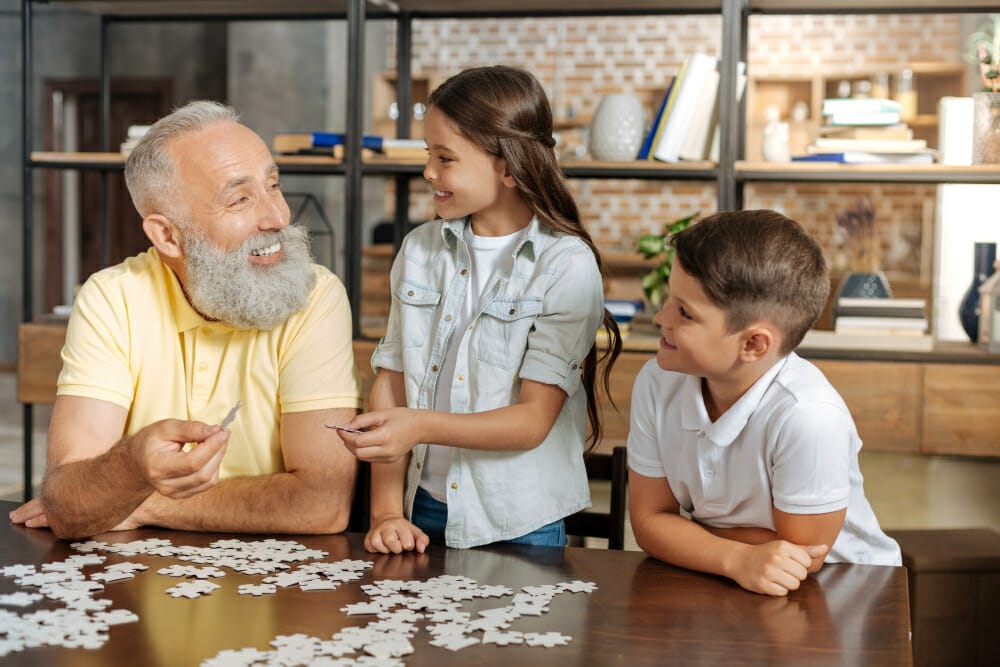“Why do Occupational Therapists (OTs) love puzzles so much?!” It is a question I’ve been asked before, and my response is, “What’s not to love?!” First developed in 1760, puzzles were a source of entertainment and education.
In the current age of technology, puzzles may seem old-fashioned, and some may describe them as “boring,” however they remain very powerful tools utilized frequently by therapists to build skills within multiple areas of development! They can be a “one-stop-shop” for building and enhancing skills in the following areas:
- Gross motor strength and endurance
- Can complete a puzzle while maintaining almost ANY position!
- Prone (tummy time)
- Facilitated sit-ups
- Lay back to retrieve piece, sit up to place piece
- Sitting on stable surface (ex. chair)
- Sitting on unstable surface (ex. inflatable cushion, therapy ball)
- Half-kneel
- Tall kneel
- Can complete a puzzle while maintaining almost ANY position!
- Fine motor manipulation
- Grasp and release (pieces with or without knobs)
- Shift (required to pick up flat pieces)
- Rotation (flipping pieces over in fingers, rotating into position)
- Visual processing skills
- Scanning
- Discrimination (color, shape, sameness/difference)
- Fixation (eyes fix on target in order to retrieve it)
- Convergence/divergence (eyes move outward/inward to focus on pieces at varying distances)
- Memory (what color/shape piece should I be looking for?)
- Cognitive skills
- Perception
- Attention to task
- Direction following (ex. “Find the corner pieces first.”)
- Memory
- Sequencing (ex. “Get the triangle first and then get the square”.)
- Problem-solving
- Organization
- Coordination
- Eye-hand coordination
- Bilateral hemisphere activation and communication (right and left sides of the brain!)
- Crossing the midline (likely occurs both visually and physically while completing a puzzle)
- Language and social skills/Emotional regulation
- Receptive and expressive language (labeling objects, adhering to verbal instruction, etc.)
- Cooperative project participation
- Frustration management
- Recognition of needing a break (for more complex puzzles)
Not only do puzzles enhance all of these areas of skill, but they can also provide hours of entertainment, and make for great birthday and holiday gifts! Since novelty elicits higher-order critical thinking skills, a new puzzle will be more challenging than a familiar puzzle. To give you an idea of the typical age ranges OT’s consider, “within expected level” for independent completion of puzzles, here is a handy chart:
| PUZZLE TYPE | AGE |
| Inset, 3-pieces | 6 – 18 months |
| Inset, 6+ pieces with visual background | 12 – 24 months |
| Inset, 6+ pieces with NO visual background | 18 months – 3 years |
| Interlocking, 6+ pieces, with visual background | 2.5 – 4.5 years |
| Interlocking, 12-piece, with NO visual background | 3 – 4 years |
| Interlocking, 24-piece | 3 – 5.5 years |
| Interlocking, large floor puzzle | 3 – 5.5 years |
| Interlocking, 48 pieces or more,up to 260 pieces | 5 – 8 years |
| 500-2,000+ pieces | 8-100 years |
You probably noticed there is a lot of overlap of these ranges, and that is because different children develop visual-spatial awareness and skills at different times. For children that have ample exposure and/or take an interest in puzzles, they may develop more advanced skills at a faster rate and earlier age. For children that find puzzles more challenging, they may try to avoid them altogether; but the keyword is EXPOSURE. The more opportunities a child has to interact with and complete puzzles, the greater chance they will become proficient! Our job is to provide them with opportunities while considering the “just right” challenge in order to foster skill development without overwhelming them. This might mean spending more time with a less advanced puzzle to promote feelings of success and confidence, and that is totally okay.
Now that I’ve convinced you to stock up on some cool puzzles for rainy days, weekends, and family vacations, here are some local places you can find some fantastic options for all ages and stages:
Barnes & Noble
HomeGoods
Target
Amazon
One final tip! Over the years, I have put several large puzzles together in collaboration with my family and friends. Once complete, I glue them together using Mod Podge (any craft store carries this) and put them in a frame! It is much cheaper than buying expensive artwork… and a special memory. Happy puzzling, everyone!
Suggested reading:
Fun and Functional Development: Aquatic Activities to Engage Your Child This Summer
References:

